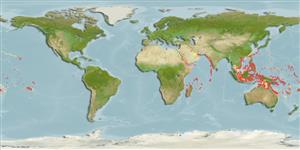Common names from other countries
Classification / Names / Names
Nomi Comuni | Sinonimi | Catalog of Fishes (gen., sp.) | ITIS | CoL | WoRMS
Environment: milieu / climate zone / depth range / distribution range
Ecologia
Associati a barriera corallina; distribuzione batimetrica 0 - 40 m (Ref. 847). Tropical; 30°N - 31°S, 32°E - 137°W (Ref. 847)
Indo-Pacific: Red Sea to Australia and Mozambique to Tuamotu Archipelago.
Length at first maturity / Size / Peso / Age
Maturity: Lm ? range ? - ? cm
Colonies are flabello-meandroid with valleys connected by a light blistery coenosteum. Vesicles are the size, and usually also the shape of grapes but may be tubular, bifurcated or irregular, depending on the state of inflation. Cream or bluish in color.
Found in protected reef environments usually in turbid waters (Ref. 847).
Life cycle and mating behavior
Maturità | Riproduzione | Deposizione | Uova | Fecundity | Larve
Members of the class Anthozoa are either gonochoric or hermaphroditic. Mature gametes are shed into the coelenteron and spawned through the mouth. Life cycle: The zygote develops into a planktonic planula larva. Metamorphosis begins with early morphogenesis of tentacles, septa and pharynx before larval settlement on the aboral end.
Veron, J.E.N. 2000. (Ref. 847)
IUCN Red List Status (Ref. 130435)
CITES status (Ref. 108899)
Not Evaluated
Human uses
| FishSource |
Strumenti
Informazioni ulteriori
Age/SizeAccrescimentoLength-weightLength-lengthMorfologiaLarveAbbondanza
Fonti Internet
Estimates based on models
Preferred temperature
(Ref.
115969): 24.9 - 29, mean 27.7 (based on 434 cells).
Price category
Unknown.
